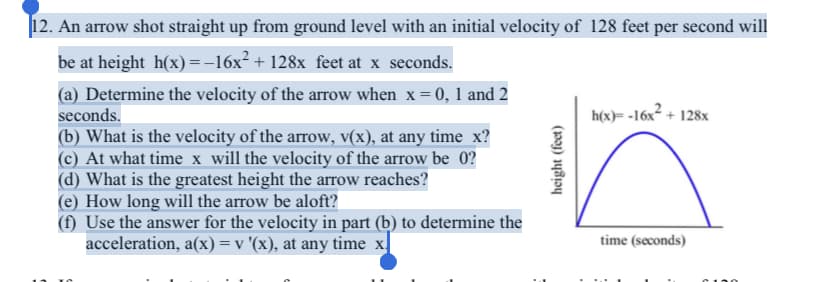12. An arrow shot straight up from ground level with an initial velocity of 128 feet per second will be at height h(x) =-16x² + 128x feet at x seconds. (a) Determine the velocity of the arrow when x= 0, 1 and 2 seconds. (b) What is the velocity of the arrow, v(x), at any time x? (c) At what time x will the velocity of the arrow be 0? (d) What is the greatest height the arrow reaches? (e) How long will the arrow be aloft? (f) Use the answer for the velocity in part (b) to determine the acceleration, a(x)= v '(x), at any time x. h(x)= -16x² + 128x time (seconds) C190 height (feet)
12. An arrow shot straight up from ground level with an initial velocity of 128 feet per second will be at height h(x) =-16x² + 128x feet at x seconds. (a) Determine the velocity of the arrow when x= 0, 1 and 2 seconds. (b) What is the velocity of the arrow, v(x), at any time x? (c) At what time x will the velocity of the arrow be 0? (d) What is the greatest height the arrow reaches? (e) How long will the arrow be aloft? (f) Use the answer for the velocity in part (b) to determine the acceleration, a(x)= v '(x), at any time x. h(x)= -16x² + 128x time (seconds) C190 height (feet)
Functions and Change: A Modeling Approach to College Algebra (MindTap Course List)
6th Edition
ISBN:9781337111348
Author:Bruce Crauder, Benny Evans, Alan Noell
Publisher:Bruce Crauder, Benny Evans, Alan Noell
Chapter2: Graphical And Tabular Analysis
Section2.1: Tables And Trends
Problem 1TU: If a coffee filter is dropped, its velocity after t seconds is given by v(t)=4(10.0003t) feet per...
Related questions
Question

Transcribed Image Text:|12. An arrow shot straight up from ground level with an initial velocity of 128 feet per second will
be at height h(x)=-16x² + 128x feet at x seconds.
(a) Determine the velocity of the arrow when x= 0, 1 and 2
seconds.
(b) What is the velocity of the arrow, v(x), at any time x?
(c) At what time x will the velocity of the arrow be 0?
(d) What is the greatest height the arrow reaches?
(e) How long will the arrow be aloft?
(f) Use the answer for the velocity in part (b) to determine the
acceleration, a(x)=v '(x), at any time x|
h(x)= -16x² + 128x
time (seconds)
C190
height (feet)
Expert Solution
This question has been solved!
Explore an expertly crafted, step-by-step solution for a thorough understanding of key concepts.
This is a popular solution!
Trending now
This is a popular solution!
Step by step
Solved in 2 steps with 2 images

Recommended textbooks for you

Functions and Change: A Modeling Approach to Coll…
Algebra
ISBN:
9781337111348
Author:
Bruce Crauder, Benny Evans, Alan Noell
Publisher:
Cengage Learning

Algebra & Trigonometry with Analytic Geometry
Algebra
ISBN:
9781133382119
Author:
Swokowski
Publisher:
Cengage

Functions and Change: A Modeling Approach to Coll…
Algebra
ISBN:
9781337111348
Author:
Bruce Crauder, Benny Evans, Alan Noell
Publisher:
Cengage Learning

Algebra & Trigonometry with Analytic Geometry
Algebra
ISBN:
9781133382119
Author:
Swokowski
Publisher:
Cengage